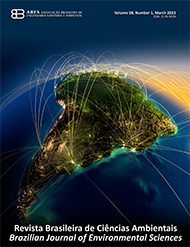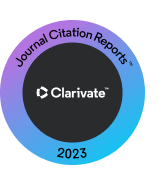Evaluation of the acute phytotoxicity of phototreated textile effluent using cucumber (Cucumis sativus) and radish seeds (Raphanus sativus)
DOI:
https://doi.org/10.5327/Z2176-94781861Palavras-chave:
bioindicador; corante; ecotoxicidade; fotocatalisador.Resumo
A água, como recurso vital, desempenha um papel crucial nas atividades humanas, notadamente na indústria têxtil, cujas operações podem impactar significativamente a qualidade desse recurso. É imperativo explorar soluções, como a adoção de processos oxidativos avançados, que englobam a degradação dos corantes presentes nos efluentes por meio da ação dos radicais hidroxila. A fim de avaliar a eficácia desse tratamento, são realizados testes de fitotoxicidade aguda para analisar as respostas de organismos vegetais aos efluentes. Diante disso, este estudo teve como objetivo avaliar a fitotoxicidade aguda de um efluente têxtil real submetido aos tratamentos de fotocatálise heterogênea e foto-fenton homogêneo. Testes de fitotoxicidade aguda foram realizados com sementes de pepino (Cucumis sativus) e rabanete (Raphanus sativus), tanto para o efluente tratado quanto innatura. Os resultados revelaram uma sensibilidade das sementes de pepino ao efluente in natura e resistência às sementes de rabanete. Em relação aos efluentes fototratados, os resultados mostraram o aumento da taxa de germinação das sementes e contribuíram para potencializar essa germinação. Também foram realizados testes fitotóxicos com cloreto de sódio e sulfato de sódio, substâncias geralmente utilizadas no processo têxtil, e pôde-se comprovar a toxicidade dessas substâncias nas sementes de pepino e rabanete.
Downloads
Referências
Al-Ansari, M. M.; Li, Z.; Masood, A.; Rajaselvam, J., 2022. Decolorization of azo dye using a batch bioreactor by an Indigenous bacterium Enterobacter aerogenes ES014 from the wastewater dye effluent and toxicity analysis. Environmental Research, v. 205, 112189. https://doi.org/10.1016/j.envres.2021.112189.
Associação Brasileira da Indústria Têxtil (ABIT), 2022. Indústria têxtil e de confecção faturou R$ 194 bilhões em 2021 (Accessed August 18, 2023) at:. https://www.abit.org.br/noticias/industria-textil-e-de-confeccao-faturou-r-194-bilhoes-em-2021.
Cesário, G.C., 2017. Fitotoxicidade de efluente de tingimentos têxteis realizados com ciclodextrina. Trabalho de conclusão de curso, Universidade Tecnológica Federal do Paraná, Apucarana. Retrieved 2017-12-01, from http://repositorio.utfpr.edu.br/jspui/handle/1/5730
Dhaouefi, Z.; Toledo-Cervantes, A.; Ghedira, K.; Chekir-Ghedira, L.; Muñoz, R., 2019. Decolorization and phytotoxicity reduction in an innovative anaerobic/aerobic photobioreactor treating textile wastewater. Chemosphere, v. 234, 356-364. https://doi.org/10.1016/j.chemosphere.2019.06.106.
Dutta, S.; Bhattacharjee, J., 2022. A comparative study between physicochemical and biological methods for effectively removing textile dye from wastewater. In: Shah, M.P.; Rodriguez-Couto, S.; Kapoor, R.T. Development in Wastewater Treatment Research and Processes. Elsevier, Haldia, India, pp. 1-21. https://doi.org/10.1016/B978-0-323-85657-7.00003-1.
Engelhardt, M.M.; Lima, F.R.D.; Martins, G.C.; Vasques, I.C.F.; Silva, A.O.; Oliveira, J.R.; Reis, R.H.C.L.; Guilherme, L.R.G.; Marques, J.J.G.S.M, 2020. Fitotoxicidade do cobre em culturas agrícolas cultivadas em solos tropicais. Semina: Ciências Agrárias, Londrina, v. 41 (6), Suplemento 2, 2883-2393. https://doi.org/10.5433/1679-0359.2020v41n6Supl2p2883.
Hadjadj, S.; Sekerifa, B.B.; Khellafi, H.; Krama, K.; Rahmani, S.; El Hadj-Khelil, A.O., 2022. Salinity and type of salt affect seed germination characteristics of the medicinal plant Zygophyllum album L. (Zygophyllaceae), native to the Algerian Sahara. Journal of Applied Research on Medicinal and Aromatic Plants, v. 31, 100412. https://doi.org/10.1016/j.jarmap.2022.100412.
Hoss, L.; Loebens, L.; Dos Santos, N.R.; Schoeler, G.P.; Silveira, M., 2019. Efeito da ozonização na fitotoxicidade de lixiviado de aterro sanitário. Congresso Sul-Americano De Resíduos Sólidos e Sustentabilidade (ConReSol); 2019 30-May; Foz do Iguaçu, Brazil. 1-6 p.
Li, M.; Li, K.; Wang, L.; Zhang, X., 2020. Feasibility of concentrating textile wastewater using a hybrid forward osmosis-membrane distillation (FO-MD) process: Performance and economic evaluation. Water Research, v. 172, 115488. https://doi.org/10.1016/j.watres.2020.115488.
Ma, D.; Yi, H.; Lai, C.; Liu, X.; Huo, X.; An, Z.; Yang, L., 2021. A critical review of advanced oxidation processes in organic wastewater treatment. Chemosphere, v. 275, 130104. https://doi.org/10.1016/j.chemosphere.2021.130104.
Mohamed, W.A.; Abd El-Gawad, H.H.; Handal, H.T.; Galal, H.R.; Mousa, H.A.; Elsayed, B.A.; Abdel-Mottaleb, M.S.A., 2023. TiO2 quantum dots: Energy consumption cost, germination, phytotoxicity studies, recycling photo and solar catalytic processes of reactive yellow 145 dye and natural industrial wastewater. Advanced Powder Technology, v. 34 (1), 103923. https://doi.org/10.1016/j.apt.2022.103923.
Moraes Júnior, J.R.; Bidoia, E.D., 2015. Color degradation of simulated textile effluent by electrolytic treatment and ecotoxicological evaluation. Water Air Soil Pollution, v. 226, 402. https://doi.org/10.1007/s11270-015-2665-2.
Nidheesh, P.V.; Ravindran, V.; Gopinath, A.; Kumar, M.S., 2022. Emerging technologies for mixed industrial wastewater treatment in developing countries: an overview. Environmental Quality Management, v. 31 (3), 121-141. https://doi.org/10.1002/TQEM.21762.
Oyeniran, D.O.; Sogbanmu, T.O.; Adesalu, T.A., 2021. Antibiotics, algal evaluations, the acute effects of abattoir wastewater on liver function enzymes, genetic and haematologic biomarkers in the freshwater fish, Clarias gariepinus. Ecotoxicology and Environmental Safety, v. 212, 111982. https://doi.org/10.1016/j.ecoenv.2021.111982.
Peduto, T.A.G.; Jesus, T.A.D.; Kohatsu, M.Y., 2019. Sensibilidade de diferentes sementes em ensaio de fitotoxicidade. Revista Brasileira de Ciência, Tecnologia e Inovação, v. 4, (2), 200-212. https://doi.org/10.18554/rbcti.v4i2.3698.
Rahmani, A.R.; Mousavi-Tashar, A.; Masoumi, Z.; Azarian, G., 2019 Integrated advanced oxidation process, sono-Fenton treatment, for mineralization and volume reduction of activated sludge. Ecotoxicology and Environmental Safety, v. 168, 120-126. https://doi.org/10.1016/j.ecoenv.2018.10.069.
Rocha, E.M.R.; Lucena, L.G.; de Almeida Porto, C., 2020. Otimização do processo foto-fenton solar no tratamento de lixiviados de aterros sanitários. Revista Tecnologia e Sociedade, v. 16 (41), 202-215. https://doi.org/10.3895/rts.v16n41.11797.
Samuchiwal, S.; Gola, D.; Malik, A., 2021. Decolorization of textile effluent using native microbial consortium enriched from textile industry effluent. Journal of Hazardous Materials, v. 402, 123835. https://doi.org/10.1016/j.jhazmat.2020.123835.
Saravanakumar, K.; De Silva, S.; Santosh, S.S.; Sathiyaseelan, A.; Ganeshalingam, A.; Jamla, M.; Wang, M.H., 2022. Impact of industrial effluents on the environment and human health and their remediation using MOFs-based hybrid membrane filtration techniques. Chemosphere, v. 307, 135593. https://doi.org/10.1016/j.chemosphere.2022.135593.
Singha, K.; Pandit, P.; Maity, S.; Sharma, S.R., 2021. Harmful environmental effects for textile chemical dyeing practice. In: Ibrahim, N.; Hussain, C.M. Green Chemistry for Sustainable Textiles. Woodhead Publishing, Patna, pp. 153-164. https://doi.org/10.1016/B978-0-323-85204-3.00005-1.
Soares, M.R.; Matsinhe, C.; Belo, S.; Quina, M.J.; Quinta-Ferreira, R., 2013. Phytotoxicity evolution of biowastes undergoing aerobic decomposition. Journal of Waste Management, v. 2013 (1), 479126. https://doi.org/10.1155/2013/479126.
Sobrero, M.C.; Ronco, A., 2004. Ensayo de toxicidade aguda com semillas de lechuga (Lactuca sativa L). In: Castillo, G. (Ed.), Ensayos toxicológicos y métodos de evaluación de calidad de águas. International Development Research Centre (IDRC), Ottawa, pp. 71-79.
Türkyilmaz, M., 2022. A comparative study of free chlorine activated by Fe+ 2 and U.V. C light catalysts in treating real and simulated textile wastewater: Optimization, reactive species, and phytotoxicity assessment. Journal of Water Process Engineering, v. 49, p. 103161. https://doi.org/10.1016/j.jwpe.2022.103161.
Viana, G.C.C.; Rocha, E.M.R.; Scapin, E.; Cahino, A.; Leite, I.R.D.; Bertuol, D. A.; Amorim, C.C., 2023. Solar photocatalysis using post-consumer alkaline batteries degrades contaminants of emerging surface water concerns. Journal of Environmental Chemical Engineering, v. 11, (6), 111226. https://doi.org/10.1016/j.jece.2023.111226.
Waghmode, T.R.; Kurade, M.B.; Sapkal, R.T.; Bhosale, C.H.; Jeon, B.H.; Govindwar, S.P., 2019. Sequential photocatalysis and biological treatment for the enhanced degradation of the persistent azo dye methyl red. Journal of Hazardous Materials, v. 371, 115-122. https://doi.org/10.1016/j.jhazmat.2019.03.004.
Zucconi, F. (Ed.)., 1981. Regulation of abscission in growing fruit. Symposium on Growth Regulators in Fruit Production; 1981 30- Jun; Ithaca, USA. ISHS Acta Horticulturae 120: L.C. Luckwill. 89-94 p.
Zou, H.; Ning, X.A.; Wang, Y.; Zhou, F., 2019. The agricultural use potential of the detoxified textile dyeing sludge by integrated Ultrasound/Fenton-like process: a comparative study. Ecotoxicology and Environmental Safety, v. 172, 26-32. https://doi.org/10.1016/j.ecoenv.2019.01.020.
Downloads
Publicado
Como Citar
Edição
Seção
Licença
Copyright (c) 2024 Revista Brasileira de Ciências Ambientais

Este trabalho está licenciado sob uma licença Creative Commons Attribution 4.0 International License.

























